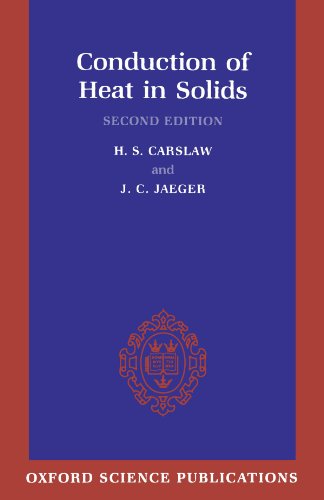Conduction of Heat in Solids ebook download
Par ament marie le vendredi, septembre 2 2016, 07:37 - Lien permanent
Conduction of Heat in Solids. H. S. Carslaw, J. C. Jaeger

Conduction.of.Heat.in.Solids.pdf
ISBN: 0198533683,9780198533689 | 517 pages | 13 Mb

Conduction of Heat in Solids H. S. Carslaw, J. C. Jaeger
Publisher: Oxford University Press, USA
Conduction is heat transfer from warm to cooler areas within a material, or between two materials touching each other. Conduction is most effective in solids-but it can happen in fluids. UNIT II CONVECTIVE HEAT TRANSFER 10. All conduction needs molecules so that the energy can be passes along. Actually 'conduction' is heat transfer in solids, such as metals. And Jaeger, J.C., Conduction of Heat in Solids, 2nd ed., Clarendon Press, Oxford, England, section 3.3, p. Transfer of heat in solids is by conduction. Transfer of heat within a fluid is by convection. Convection; that is, the transfer of heat from one place to another through the movement of fluids or gases. Convection and conduction are different because conduction transfers heat energy through direct contact in solids. Gases, such as air, do not conduct heat very well. Heat Conduction: Lumped System Analysis – Heat Transfer in Semi infinite and infinite solids – Use of Transient – Temperature charts – Application of numerical techniques. Strictly speaking, in fluids the transfer of energy through Brownian motion is called diffusion. Conduction; that is, heat being transferred from a heated solid to an unheated solid. When the distance between two solid objects of differing temperatures goes to zero and they come into direct contact, the heat exchange between them is then called conduction. Liquids: Most of the liquids transfer heat very well. Such bad conductors of heat are called insulators. For example, a spoon in a cup of hot soup becomes warmer because the heat from the soup is conducted along the spoon. I am having trouble with a flow simulation for a school senior design project. Heat Conduction(Linear and Radial Heat Conduction in Different Types of Solids)Objectives: 1. Conduction is the one of three types of heat transfer in which thermal energy transfers from one point to another through the interaction between the atoms or molecules of the matter.